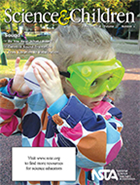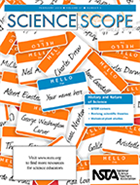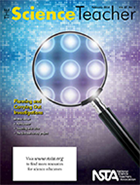NSTA’s K-12 Science Education Journals: February Issues Online
By Lauren Jonas, NSTA Assistant Executive Director
Posted on 2014-02-08
It’s February, and many of us are focused on groundhogs, candy, and hoping never to hear the words polar vortex again! Spring is still a few months away, so this is a good time to bundle up and get a fresh look at what your science teaching peers are doing. The National Science Teachers Association (NSTA) produces grade-level journals, written by educators, for educators, and they are targeted to your teaching level. NSTA’s February K-12 journals are live online (with select articles being free for all, and full content being free to all NSTA members). Browse these issues for classroom-tested ideas, activities you can use tomorrow, and commentary from experts in the field.
 Science and Children
Science and Children
Since children experience sound even before birth, it is easy to assume that they know a great deal about it. However, ideas about sound are some of the most common misconceptions held by young children.
Featured articles (please note, only those marked “free” are available to nonmembers):
- Close Encounters of the Amphibious Kind
- Creative Sound Dramatics
- Do You Hear What I Hear?
- Free – Editor’s Note: Sound
- From Vibration to Vocalization
- Free – The Sound of Science
- Full Table of Contents
 Science Scope
Science Scope
The Next Generation Science Standards affirm that students need to develop a thorough understanding of the entire enterprise of science, including the history and nature of science. Use the activities found in this issue to explore the complexities of this very human endeavor.
Featured articles (please note, only those marked “free” are available to nonmembers):
- Free – Career Simulations: Technology Tools That Support STEM Content and Motivation
- Connecting Students to STEM Careers
- Don’t Swat That Fly! Using House Flies in an Inquiry Activity
- Free – Editor’s Roundtable: Teaching the Nature of Science: Let the Story of Science Lead the Way
- Evolutionary Technology: Using Google Earth, Cyber Databases, and Geotagged Photos to Enhance Students’ Scientific Practices and Understanding of Darwin’s Theory of Evolution
- Historical Plant Studies: Tools for Enhancing Students’ Understanding of Photosynthesis
- Science Evolving
- The History and Nature of Science: Is the Past the Key to Our Future?
- Tracking Science: Following the STEM Trend
- Full Table of Contents
 The Science Teacher
The Science Teacher
Although the practice of planning and carrying out investigations has always been a part of good science instruction, the student focus often has been more on carrying out than on planning, with teacher-structured investigations far outnumbering student opportunities to develop their own research questions. Giving students opportunities to design and plan investigations allows them to truly experience the excitement of science and better understand the nature of scientific inquiry. Just as basketball players need to practice shooting, passing, dribbling, and defense, so too do our science students need to practice real science by asking questions, designing investigations, analyzing data, and communicating results. Engaging in these practices helps students appreciate the wide range of approaches used in science and engineering to investigate and explain the world.
Featured articles (please note, only those marked “free” are available to nonmembers):
Disclaimer: The views expressed in this blog post are those of the author(s) and do not necessarily reflect the official position of the National Science Teaching Association (NSTA).


